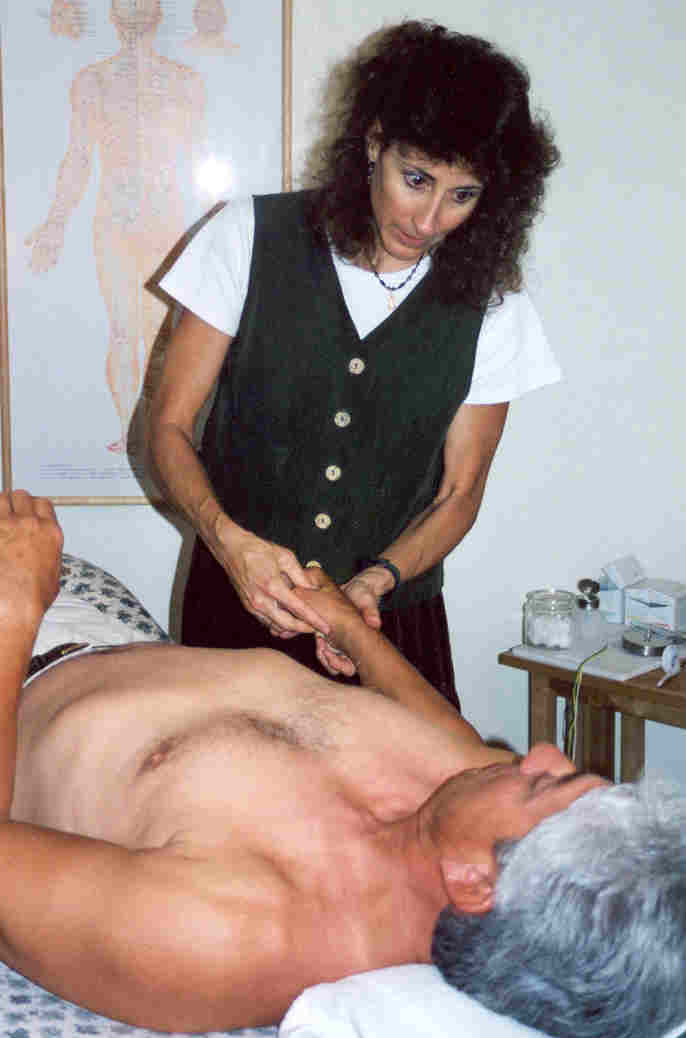| ACUPUNCTURE
AND SPINAL CORD INJURY – SUMMARY OF KEY STUDIES |
|
|
Dr.
Margaret Naeser, Ph.D.,
Lic.Ac., Research Professor of Neurology, Boston University School of
Medicine and Neuroimaging/Aphasia Research Program, VA Boston Healthcare
System
|
|

Go To
Acupuncture Overview
This
article briefly summarizes the findings of key studies focused on the
use of acupuncture to treat spinal cord injury (SCI). In part, this
summary was taken from my invited report for the National Institutes of
Health’s (NIH) Consensus Devel opment Conference on Acupuncture held in
November of 1997 (proceedings published by NIH in 1997 (pp.93 –109)). opment Conference on Acupuncture held in
November of 1997 (proceedings published by NIH in 1997 (pp.93 –109)).
The
attached Table summarizes results from three studies performed in China
before the 1997 conference (see Gao, 1984; Gao et al., 1996; Wang,1992).
None of these studies had a control group. Overall, 340 out of the 360
cases (i.e., 94.4%) had beneficial outcomes, including reduction in
muscle spasms, some increased sensation, improved bladder and bowel
function. Treatment duration ranged from five months to two to three
years, or even five years. Electroacupuncture along the Bladder meridian
(paravertebral) area was especially recommended. Authors recommend
beginning acupuncture as soon as possible after SCI, even during the
acute stage of spinal cord shock, to help reduce the development of
spasms. The acupuncture treatments were also helpful in the treatment of
decubital ulcers. even five years. Electroacupuncture along the Bladder meridian
(paravertebral) area was especially recommended. Authors recommend
beginning acupuncture as soon as possible after SCI, even during the
acute stage of spinal cord shock, to help reduce the development of
spasms. The acupuncture treatments were also helpful in the treatment of
decubital ulcers.
Additional
studies have been published since 1997 which support these findings.
Honjo, et al. (2000) from Japan observed that needle stimulation of
acupuncture point Bladder 33 (third posterior sacral foramina)
significantly improved bladder incontinence. Cheng et al., (1998) from
Taiwan observed that cases receiving electroacupuncture (acupuncture
points CV 3, 4 and Bladder 32) achieved balanced voiding in fewer days
than cases who received no acupuncture. Cases starting acupuncture
treatment within three weeks after injury required significantly fewer
days of treatments compared to those treated with acupuncture after
three weeks. Cases with complete spinal cord injury, either with
pronounced detrusor-sphincter dyssynergia in upper motor neuron lesion
or with persistent areflexic bladder in lower motor neuron lesion, were
not affected by acupuncture.
Yu
(1993) from Beijing Medical University observed that 100 Hz
electroacupuncture (EA) (two times/day, 30 min/time) for three months
had an antispastic effect on the limbs which was stable, but required
additional long-term, follow-up treatments. He concluded that 100 Hz EA
"decreased the excitability of the motor neurons in the anterior
horns through the kappa opiate receptors, thus ameliorating the muscle
spasticity of spinal origin."
ACUPUNCTURE TO TREAT SPINAL
CORD INJURY
|
Authors |
Number of Cases |
Positive Results |
| Gao,
1984 Yuci City Institute of Paralysis, Shanxi Province, China |
17
inpatients with complete traumatic paraplegia. Acute cases,
1-month post-onset and chronic cases, 5-years post-onset. Treated
over a 2-3 year period. |
15/17
cases or 88%
Includes
improvement in the following: Reduction in muscle spasms,
increased level of sensation, and improved bladder and bowel
function.
Recommends
beginning acupuncture as soon as possible after spinal cord
injury, even during early stage of spinal shock, to reduce
occurrence of spasms. Younger patients had better outcome. |
| Wang
1992, Institute of Health Preservation, Beijing, China. |
82
cases treated with acupuncture/electroacupuncture along the
bladder meridian (paravertebral) for 5 months |
76/82
cases or 93%, “Effective”
Includes
improvement in lower limb paralysis and bladder and bowel function
|
| Gao,
Gao, Gao, Han, Han, Han, and Han 1996, Paralysis Institute, Shanxi
Province, China |
261
cases treated beginning at 1 month post-onset to over 5 years
post-onset. |
249/261
or 95%, “Effective”
“Effective”
defined as basic recovery of functions of the nervous system
with ability to walk freely, and almost voluntary urination; marked
effectiveness with partial recovery of functions of the
nervous system, with ability to walk on crutches and restoration
of urinary bladder reflex (35.2%); improvement of nervous
system functions with some limb movement, defecation and/or
urination (57.1%).
Recommended
beginning acupuncture as soon as possible after SCI |
References
·
Cheng
PT , Wong MK, Chang PL. A therapeutic trial of acupuncture in neurogenic
bladder of spinal cord injured patients--a preliminary report. Spinal
Cord 1998 July; 36(7):476-80.
·
Gao
XP. Acupuncture for traumatic paraplegia. International Journal of
Chinese Medicine 1984;1 (2):43-47.
·
Gao
XP, Gao CM, Gao JC, Ran CG, Ran F, Ran B, Ran L. Acupuncture treatment
of complete traumatic paraplegia- Analysis of 261 cases. Journal of
Traditional Chinese Medicine 1996;16(2):134-137.
·
Honjo
H, Naya Y, Ukimura O, Kojima J, Miki T. Acupuncture on clinical symptoms
and urodynamic measurements in spinal-cord injured patients with
detrusor hyperreflexia. Urologia Intemationalis, 65 (4):190-195.
·
Wang
HJ. A survey of the treatment of traumatic paraplegia by traditional
Chinese medicine. Journal of Chinese Medicine 1992;12(4):296-303.
·
Yu
Y. Transcutaneous electric stimulation at acupoints in the treatment of
spinal spasticity: effects and mechanism. Zhonghua Yi Xue Za Zhi
1993 Oct; 73(10):594-5, 637.
TOP |
|
|
|
|
|
|
|
|
|
|